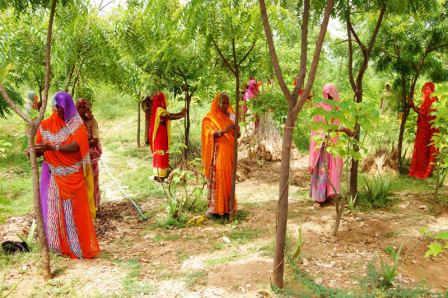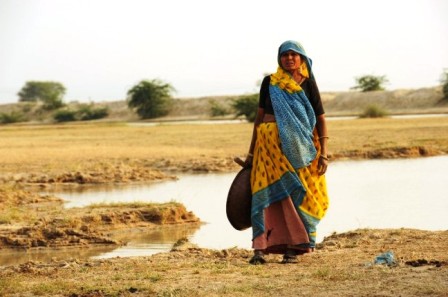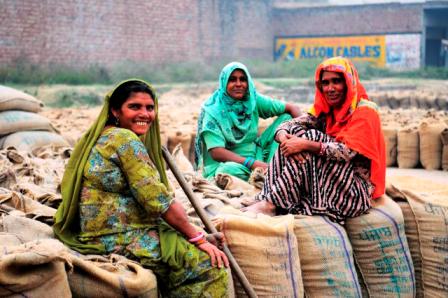What is ecofeminism?
The term ‘ecofeminism’ is credited to the French feminist Françoise D’Eaubonne, who coined it in 1974. As with many concepts and philosophies, there is no one single definition of ecofeminism that proponents agree on. You can think of it as ecology + feminism although that’s a bit too simplistic. Nevertheless, key elements can be identified to enable a working knowledge and understanding of it. Simply put, ecofeminism explores the relations between the female gender and the environment, the similarities and closeness of both, and their lower, oppressed status as compared to dominant groups and priorities. The underlying belief is this: both the environment and non-male genders (this includes women, transgender, intersex people) have a lower status than men and are subjected to rampant discriminations, blithe apathy, and callous harm. Ecofeminism seeks to bring together these two forces insofar as working for the environment is connected to dismantling of patriarchy, or a more egalitarian world in any case.
As the online bible of feminism, everydayfeminism.com states quite lucidly: ‘Examining environmental issues with a feminist lens enables us to see the intersection of gender, socioeconomics, and the environment.’ The key thought here is that ecofeminism facilitates an alternate, more humane understanding of the world.
A distinctive aspect of ecofeminism is that it doesn’t aim for equality with men; rather, it emphasises and owns the innate and natural female capabilities like birthing and menstruation and thereby seeks the liberation of women as women, and not in the context of a dominant male gender. In the dualist view that is prevalent in modern, capitalist and deeply patriarchal societies, every concept is split along a ‘good’ and ‘bad’ side, male-female, mind-body, culture-nature, reason-emotion, and so on. Hence, qualities associated with the ‘female’ – like motherhood, nurturing, collaboration, emotions, etc. – are negatively viewed and deemed ‘soft’, ‘irrational’ and of little practical use. In a similar vein, environment is given less importance and treated as an inconvenient afterthought to more important pursuits of materialistic and measurable goals. Both are seen as lesser than high-priority attributes like productivity, an analytical mindset and numerical values (Cartesian, if you will) and, hence, are fair game for exploitation. This binary worldview is extended to everything including gender and ends up hurting everyone, more so the oppressed sections which include genders other than male, non-cisgender and non-white people, the poor and the disabled, to name a few. Ecofeminists reject this value-hierarchical mode of thinking.
 Some background
Some background
Ecofeminists hark back to the time before written history, some 250,000 years ago, when humans were close to nature and lived alongside it in harmony while being communal and cooperative with each other. Nature was something to be treasured, nurtured and revered. The marked shift in the severance from nature is believed to have happened some 20,000 years ago when humans moved from being hunter/gatherer to farming and domesticating animals.
Others identify the 18th-century European Enlightenment period as the critical time that gave birth to the modern, scientific, obsessively numbers-focused culture leading to the capitalist societies that we find ourselves in today, wherein nature and people are merely resources to be harnessed for the betterment of a few. Patriarchy itself is only 5,000 years old but has already managed to bring a 4.5 billion old Earth to the brink of extinction. This anthropocentric view seems natural to us, much like the air we breathe, so much so that we barely stop to think about it. But the world is naturally not predisposed to serve humans. If anything, this living planet needs and thrives on the natural environment, with humans a raucous, bossy part of it. Ecofeminists understand and appreciate this. Even today, indigenous people are leading the way in preserving their environment by refusing to give in to the material ‘progress’ that is the hallmark of the current generation. As articulated by Noam Chomsky, it is they who are fighting to save the earth; examples include Canada’s First Nations people opposing fossil fuel developments and groups in Latin America resisting the further exploitation of their land and resources. In India too, it is the adivasis who have stood up time and again in opposition to the State and powerful corporate groups hell-bent on mining every inch of their lands and clearing forests to fund their revenue targets.
|
But the world is naturally not predisposed to serve humans. If anything, this living planet needs and thrives on the natural environment, with humans a raucous, bossy part of it. Ecofeminists understand and appreciate this. Even today, indigenous people are leading the way in preserving their environment by refusing to give in to the material ‘progress’ that is the hallmark of the current generation. As articulated by Noam Chomsky, it is they who are fighting to save the earth. |
An interesting debate within ecofeminism is whether there are innately male and female characteristics. Some are of the opinion that these categorisations are societal in nature and believe that both have the ability to explore the full spectrum of various human attributes and develop deeper relations with the environment. Others disagree and believe that women have qualities that are inbred and instinctive to them and, as a result, are more close to nature than a man can ever hope to be. This is called the essentialist way of thinking. Their proponents did cause much harm to the perception of ecofeminism within feminist circles.
With rapid industrialisation, mining, pumping and harvesting of every natural resource out there, and the resultant cataclysmic effect on the environment and its dependent flora and fauna, perhaps it was inevitable that a movement like feminism – which seeks to dismantle traditional power structures and inequities – would find a kindred spirit in our damaged ecology. Even though ecofeminism had its genesis in the 1970s, it became a prominent part of the feminist discourse only in the next decade. However, movements linked to the philosophy of ecofeminism had sprung up even before that, thanks to the growing realisation that gender equality had much in common with other social-justice causes, including those for protecting the environment. Even though ecofeminism did inspire, directly or indirectly, several environmental movements championed by women, due to its association with essentialism (as discussed earlier), it was slowly disowned by many feminists and faced plenty of criticism. Nevertheless, it still has its backers and remains an essential branch of modern-day feminism. After all, when one talks about intersectionality, it would be criminal to leave out the one thing that binds us all to the Earth – that is, nature.
Ecofeminist-inspired movements
In many places in the world, women were the first to protest against environmental damage. Perhaps the most well-known instance of women joining forces to save the environment is the Chipko movement, which is today seen as a shining example of what ecofeminism is capable of. Although it is formally recognised to have started in 1973, the origins can be traced back to the early part of the 18th century in Rajasthan, where 84 villagers led by Amrita Devi risked their lives to prevent the destruction of trees on orders from the king of Jodhpur. Since then and especially after Independence, the forest cover in India had seen (and continues to see) a gradual dwindling. This resulted in soil erosion, decrease in the quality of soil, water shortages, etc. The brunt of these effects were felt by the poor, the farming communities who were dependent on these precious resources, and those for whom forests were the main sources of livelihood. Also, forest conservation policies at that time restricted local people from accessing these forests for their own use.
 The Chipko movement started in the village of Mandal in the upper Alakananda valley in present-day Uttarakhand. This was in response to a government contract awarded to a sporting goods company to cut down trees for tennis rackets. This landmark protest included sloganeering, beating of drums, and the famous tree-hugging action that gave the name to this movement. It soon spread across different districts in Uttar Pradesh over the next few years, with villagers resorting to nonviolent means and constant vigilance to protect the trees against incessant felling. Their demand was simple: conserve the environment and make sensible use of the forests. The defining feature of this movement was the participation of women, who were the major force driving it, even though there were prominent male leaders as well. Being highly dependent on the local agrarian economy, it was perhaps inevitable that they would be the main strength of this campaign, since they were the ones most affected by deforestation and its damaging and often irreversible fallouts. What was even more impressive about it were the many questions, debates and discussions that it spawned off relating to environment, ecology and economic issues. The villagers demanded that local communities should be allowed to control these resources while ensuring that their environment is protected from any harm. Outside intervention, especially in the guise of ‘development’, was discouraged. Concerns around local, small industries, minimum wage and farmers’ rights were also taken up.
The Chipko movement started in the village of Mandal in the upper Alakananda valley in present-day Uttarakhand. This was in response to a government contract awarded to a sporting goods company to cut down trees for tennis rackets. This landmark protest included sloganeering, beating of drums, and the famous tree-hugging action that gave the name to this movement. It soon spread across different districts in Uttar Pradesh over the next few years, with villagers resorting to nonviolent means and constant vigilance to protect the trees against incessant felling. Their demand was simple: conserve the environment and make sensible use of the forests. The defining feature of this movement was the participation of women, who were the major force driving it, even though there were prominent male leaders as well. Being highly dependent on the local agrarian economy, it was perhaps inevitable that they would be the main strength of this campaign, since they were the ones most affected by deforestation and its damaging and often irreversible fallouts. What was even more impressive about it were the many questions, debates and discussions that it spawned off relating to environment, ecology and economic issues. The villagers demanded that local communities should be allowed to control these resources while ensuring that their environment is protected from any harm. Outside intervention, especially in the guise of ‘development’, was discouraged. Concerns around local, small industries, minimum wage and farmers’ rights were also taken up.
The Chipko movement achieved a major victory in 1980 with a 15-year ban on green felling in the Himalayan forests ordered by the then central government. With its growing international prominence, it became a watershed moment in the global fight of the poor against environmental damage, which always hurts them the most”and much before it even makes a dent in the lives of the rich.
Another cornerstone of ecofeminist efforts is the Nobel Peace Prize Laureate Wangari Maathai’s Green Belt Movement. Founded in 1977 by Maathai under the National Council of Women of Kenya (NCWK), it started as a local community effort to plant trees due to the rampant environmental destruction caused by deforestation and plundering of natural resources. As always, it were the indigenous, rural women who bore the brunt of this and they, therefore, raised their voices against the lack of clean water, shortage of firewood, and food insecurity. The loss of economic safety led to increasing social and political problems within these communities. The Green Belt Movement was a response to these urgent calls for help. As part of this movement, planting of trees for soil conservation, campaigns against land grabbing and deforestation, and community seminars on environment education were taken up. Gradually, it has taken up issues around income generation, capacity building, and women empowerment as well, understanding the deep connections between the environment and the conditions of women. To date, over 51 million trees have been planted and thousands of women trained in income-generating skills. The Nobel Committee recognised Maathai’s work in 2004.
Some other well-known instances of ecofeminist movements are the Greenham Common Peace Camp in England, which was instrumental in the removal of nuclear missiles there; the Mohawk women along the St Lawrence River who established the Akwesasne Mother’s Milk Project to monitor PCB toxicity; and in Democratic Republic of Congo, where the Women’s Earth and Climate Action Network International (WECAN) and the Synergy of Congolese Women’s Associations (SAFECO) jointly work to raise awareness on deforestation, empowering local indigenous women to adapt to the effects of deforestation.
Why women are at increasing risk of global-warming changes
The answer as to how and why women are more susceptible to negative effects of ecological degradation is multilayered. Starting from the biological reproductive function of a woman’s body, whose twin characteristics are vulnerability and strength, the existing ecosystem can influence her and the child’s health especially during pregnancy, thereby affecting her fertility and the overall future population. Early childbearing and high fertility usually result in poor health and lower levels of education, which means lower income and bigger obstacles for these women to respond to climate change. As primary caregivers, women’s financial independence is gradually diminished (thanks to unpaid labour like childcare, fetching of water, domestic chores, etc.) and any health issues arising from pollution and other natural disasters leave them at the mercy of others, with high risks of violent consequences (such as slavery and trafficking). In many societies, women also do the bulk of the work related to gathering of food, firewood and water, often assisted by their young children. Globally, women and children collectively spend 140 million hours per day collecting water. With fewer resources, global warming, and an increasingly toxic environment, they are exposed to the ramifications of these phenomena much more than their male counterparts. The situation is as grim for women in urban areas as well since they occupy a majority of jobs which require them to deal with toxic chemicals – think of women engaged in house cleaning (most maids are women), sweeping, nail salons, etc. Most women also do not have any right to property, leading to further marginalisation.
In terms of climate change, it has been well documented by various organisations including the UN that women (and the poor) will be far more affected by it while having lesser means to adjust to this new normal. Their precarious condition will be further exacerbated in poor, developing countries. Women tend to be poorer, have lower income, are more dependent on the natural environment for their livelihood, and have less access to navigate the realities of a warming planet thanks to existing societal structures. Due to their lower social and economic status, their specific needs and risks are often ignored and overlooked while their voices are casually suppressed. They are also excluded from the decision-making process in their households and local communities.
 Loss of food security, which is a major side effect of global warming, has tremendous negative impact on women since they account for 45 to 80 per cent of all food production in developing countries. Their roles as fuel and water gatherers (63 per cent of households in rural sub-Saharan Africa) mean that with decreasing availability of natural resources, the increasing distances that need to be covered, the decreasing time for school and other chores, and the deadly exposure to contamination and all kinds of diseases, their health risks become even greater, not to mention the lower chances of their education or empowerment. Climate change also results in rapid migration of the poor to urban areas to improve their chances of survival. As per studies, this results in higher death rates for women in the least developed countries, due to their lower status with little or zero attention given to their needs. Occurrence of violence against women also increases manifold in these situations. In Kenya during the 2011 drought, while the men migrated away with livestock, women were left in charge of households with little resources, leading to petty trade and prostitution.
Loss of food security, which is a major side effect of global warming, has tremendous negative impact on women since they account for 45 to 80 per cent of all food production in developing countries. Their roles as fuel and water gatherers (63 per cent of households in rural sub-Saharan Africa) mean that with decreasing availability of natural resources, the increasing distances that need to be covered, the decreasing time for school and other chores, and the deadly exposure to contamination and all kinds of diseases, their health risks become even greater, not to mention the lower chances of their education or empowerment. Climate change also results in rapid migration of the poor to urban areas to improve their chances of survival. As per studies, this results in higher death rates for women in the least developed countries, due to their lower status with little or zero attention given to their needs. Occurrence of violence against women also increases manifold in these situations. In Kenya during the 2011 drought, while the men migrated away with livestock, women were left in charge of households with little resources, leading to petty trade and prostitution.
When it comes to natural disasters (a frequent corollary of global warming), it has been found that in societies with greater gender disparity, more women die compared to men, not to mention their higher vulnerability in the aftermath. For instance, women are less likely to have been taught swimming or own mobile phones to seek help. In the 1991 Bangladesh cyclone, among the 150,000 people killed, 90 per cent were women; and in Aceh, during the 2004 tsunami, more than 75 per cent of those who died were women, resulting in a male:female ratio of 3:1 among the survivors. Interestingly and not without some irony, women also produce less greenhouse gas emissions than men.
 The ecofeminist way to heal the earth
The ecofeminist way to heal the earth
While the gender gap in terms of climate change is being recognised, plans to find specific solutions for the same are missing. The benefits of involving women, especially indigenous ones, in these efforts to mitigate global warming are well known – not only do women have a good understanding of the environment and natural resources, paying heed to their voices will also help in improving their current, discriminated status. As they are responsible for household maintenance, deeply involved in food gathering, and are primary caregivers, women also tend to be more responsive and vocal about any negative impact on the natural ecosystem around them. Research shows that women place higher priority on health and income stability when given decision-making powers. For instance, SEWA launched a campaign in 1995 in Gujarat to improve the local water supply systems and reduce the time women spent gathering water. Through localised strategies, including taking the local communities in confidence, women ended up earning higher incomes because they had more free time to do other work.
However, despite all these evidences, men and those in power find it easy to drown out their voices. Hence the under-representation of women in climate-change policy, agenda setting, and planning. For example, women were not explicitly identified as vulnerable groups or important stakeholders in key climate-change treaties such as the United Nations Framework Convention on Climate Change and the Kyoto Protocol. A gender-responsive global plan to combat climate change is not only necessary, it should also be top priority. While COP21 did mention gender equality in the section related to climate change and human rights, one would prefer unequivocal and official sanctioning of women’s unique vulnerability and contributions to the biggest issue plaguing our planet.
 At a time when feminism is becoming, thankfully, more intersectional with race, class, disability, transgender and LBTQIA+ concerns being embraced by it, the most pertinent and urgent issue of our times is strangely missing from mainstream feminist discourse. Climate change is happening and the best the world can hope is to minimise its effects. Feminists have been known to highlight, critically analyse, and provide solutions to many pressing issues historically avoided by the powers that be; it is time they do the same with the environment. Ecofeminism can help tremendously in this noble mission. While its heydays of the ’80s and ’90s are gone, there is still a lot that this particular branch of feminist philosophy can provide in terms of its understanding of the deep and enduring relationship between nature and women. The many social movements that it has directly or indirectly sparked are a testament to its power and potential. Modern feminists would be well advised to harness it.
At a time when feminism is becoming, thankfully, more intersectional with race, class, disability, transgender and LBTQIA+ concerns being embraced by it, the most pertinent and urgent issue of our times is strangely missing from mainstream feminist discourse. Climate change is happening and the best the world can hope is to minimise its effects. Feminists have been known to highlight, critically analyse, and provide solutions to many pressing issues historically avoided by the powers that be; it is time they do the same with the environment. Ecofeminism can help tremendously in this noble mission. While its heydays of the ’80s and ’90s are gone, there is still a lot that this particular branch of feminist philosophy can provide in terms of its understanding of the deep and enduring relationship between nature and women. The many social movements that it has directly or indirectly sparked are a testament to its power and potential. Modern feminists would be well advised to harness it.
An ecofeminist approach could do well in highlighting the deep and insidious effects of a hierarchical and exploitative society that rests on subjugating the environment and oppressed communities to its short-sighted and selfish needs. Just like corporates continue to treat nature ever so cavalierly to massage their never-ending quest for increased revenue, people from marginalised groups such as the disabled and transgenders continue to be unseen and unheard, while women are expected to continue with their unpaid caregiving and domestic labour, all in the guise of ‘love’ and ‘natural instincts’. These entities continue to be under-represented, ignored, and generally thought little of. Profits and patriarchy rule the roost.
An ecofeminist approach has the ability to speak truth to power. It would work towards getting all stakeholders, including governments and companies, to commit to maintaining a healthy environment, while recognising the unequal ways in which climate change harms different groups. It would give credence to the legitimate demands of extremely poor nations (especially those most at risk of global warming effects), even if it means placing additional requirements on privileged groups and countries. Equal representation and diversity wouldn’t be just buzzwords, it would form the edifice of ongoing and future policies. It would take away the focus from a white-male anthropocentric view and make indigenous and other marginalised communities front and centre of all efforts to combat climate change. Environment wouldn’t just be a topic for discussion and debate, it would be treated as the most important stakeholder. The interdependence and linkages between nature and humans would be the starting points of all agenda and actions designed to keep the earth clean and green. Given the barely binding resolutions of COP21 and the half-hearted attempts by most organisations and governments on climate change, alternative approaches are needed. Ecofeminism may not be the most popular type of feminism preached in today’s times but it may just be the most relevant.

